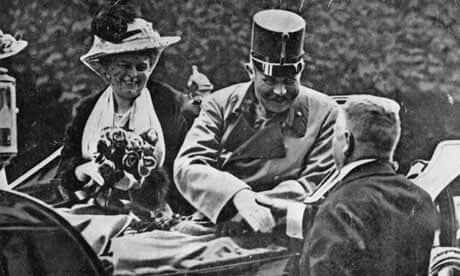The blood-splattered shirt of Archduke Franz Ferdinand, whose assassination in 1914 triggered the outbreak of the first world war, is to go on display in Vienna on Friday.
The once white garment, now stained a dark brown, is to be exhibited in a glass vitrine at the Austrian Military Museum (HGM), which holds more artefacts related to the assassination than any other institute.
"This is the undershirt he was wearing beneath his uniform, directly on his skin, so it's much more blood-soaked than the uniform he wore over it," said Thomas Reichl, of the museum.
The shirt was in the possession of the Jesuit religious order until 2004 when it was discovered gathering dust in their archives and passed to the HGM on permanent loan. Because of its delicate condition it is only rarely put on public display. This time it will be viewable for 12 days in a dimly lit room.
A Jesuit priest and family friend accompanied the archduke and his pregnant wife, Sophie, to Sarajevo where they had been sent by Emperor Franz Joseph to inspect Bosnian military manoeuvres. The priest gave the couple the last rites and was later handed the shirt and the assassin's Browning pistol for safekeeping.
Travelling in an open-top car on 28 June 1914, the archduke was shot at by 19-year-old Gavrilo Princip, a Serb who sought unity for the Yugoslav states and their independence from Austria-Hungary.
He was able to take close aim at the archduke's car when it stalled close to the Latin Bridge. The archduke and his wife, who flung herself on her husband to try to protect him and was shot in the abdomen, both died of their injuries shortly afterwards.
The chaise longue on which the archduke died is among the many artefacts relating to the assassination on display at the HGM. Others include the open-top Gräf & Stift imperial car, a rose the duchess wore in her belt and three of the four weapons used to assassinate them.
"We're expecting a large interest in the shirt because it goes on display so rarely, and especially in the run-up to the 100th anniversary of the assassination next June," said Reichl.
The exhibition is likely to further fuel the enduring fascination with the assassination as the centenary approaches, though certain artefacts are nowadays considered too distasteful to be put on display.
At one time an anatomical institute in Vienna exhibited the pickled brains of Princip, who died in prison in Theresienstadt in 1918, before they were given up for burial. The Latin Bridge remains one of Sarajevo's main tourist attractions, though the pavement on which Princip stood to fire his shots, which had been embossed with his footprints, was destroyed in the 1992-95 war in Bosnia.
By June next year the museum, which attracts 170,000 visitors a year, expects to have completed an expansion project in which its exhibition on the first world war will be extended over three floors.
